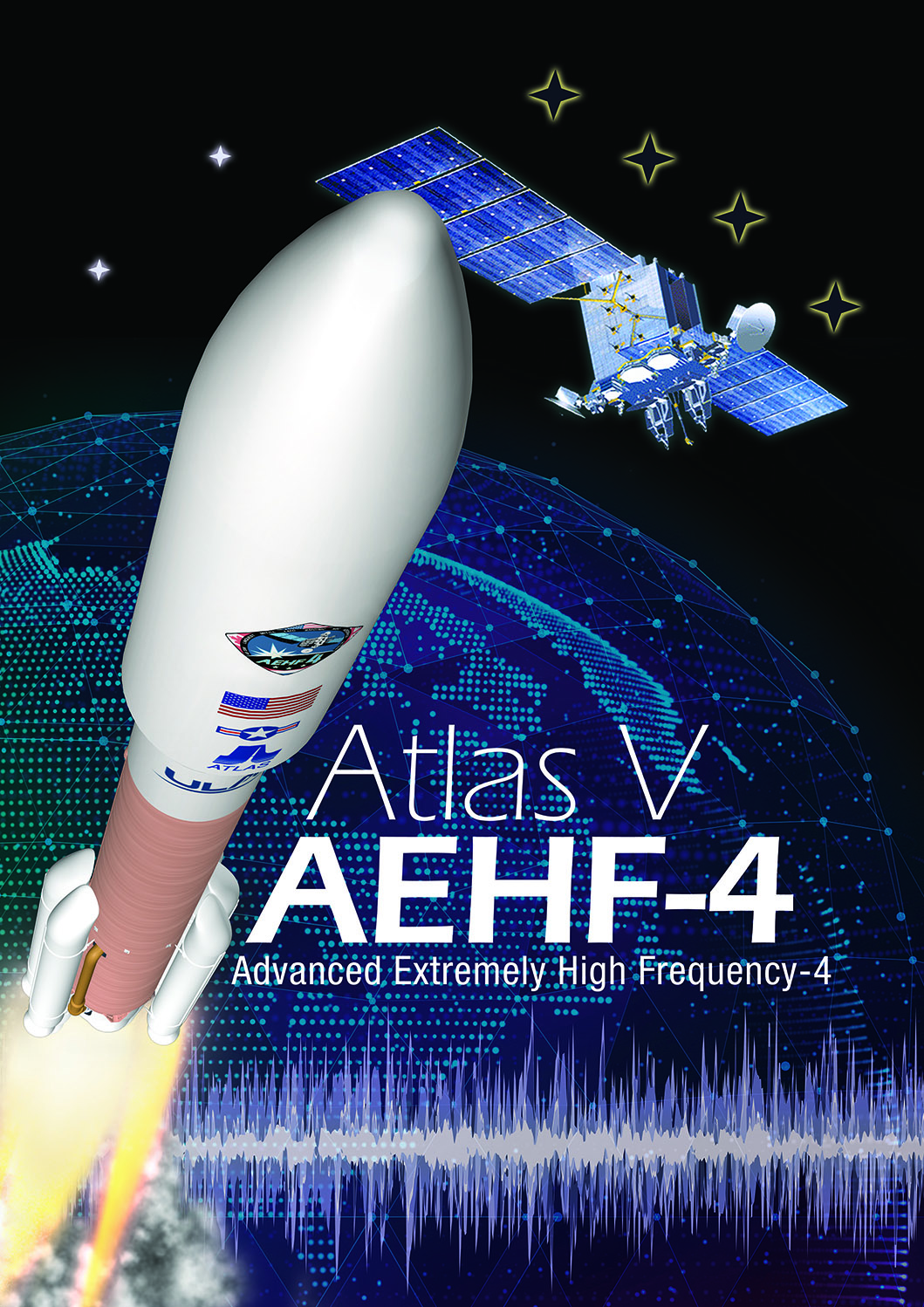Live Updates
Oct. 12 -- LRR completed
Welcome to our Live Launch Updates Blog for the AEHF-4 mission, bringing you official and timely information during the Atlas V rocket’s countdown and flight.
Liftoff of the United Launch Alliance Atlas V rocket carrying the Air Force’s AEHF-4 communications satellite from Cape Canaveral Air Force Station in Florida is scheduled for 12:15 a.m. EDT (0415 UTC) on Wednesday.
The Launch Readiness Review, moderated by Bill Cullen, ULA’s AEHF-4 launch director, was completed this morning. Managers from ULA and the Air Force assessed the readiness of the rocket, payload and mission assets, discussed the status of pre-flight processing work, heard technical overviews of the countdown and flight, and previewed the early weather forecast.
At the conclusion of the meeting, senior leaders were polled and gave a unanimous “go” for launch. Officials then signed the Launch Readiness Certificate.
Join us for live reports during the Atlas V’s journey to the launch pad on Monday and then Tuesday evening during the countdown.
Our automatically-refreshing blog -- coming to you from the Atlas Spaceflight Operations Center -- will bring you countdown coverage beginning at 5:15 p.m. EDT (2115 UTC) on Tuesday.
The official launch weather forecast, according to the 45th Weather Squadron, calls for an 80 percent chance of favorable conditions for the liftoff, with scattered low- and high-level clouds, a chance of isolated showers in the area, southeasterly winds at 10 knots, and a temperature nearly 80 degrees F. The only concern for a launch weather rule violation will be cumulus clouds.
Oct. 13 -- Launch preview
United Launch Alliance is using the Atlas V 551 rocket, with a five-meter-diameter payload fairing and a full complement of five strap-on solid rocket rockets, to launch the fourth Advanced Extremely High Frequency (AEHF-4) communications spacecraft into an optimized geosynchronous transfer orbit for the U.S. Air Force. Liftoff is planned for early Wednesday at 12:15 a.m. EDT (0415 UTC).
Leaving the pad on 2.6 million pounds of thrust from the combined power of the kerosene-fueled first stage main engine and all five solid boosters, the Atlas V will perform pitch, yaw and roll maneuvers to align with a due east heading along a flight azimuth of 90.7 degrees.
The vehicle will hit Mach 1, the speed of sound, in 35 seconds and pass through Max Q, the region of maximum dynamic pressure, at 48 seconds.
The solid boosters will burn out and separate in less than two minutes. The payload fairing that protected the satellite during atmospheric ascent will be jettisoned at the edge of space three-and-a-half minutes into flight.
Cutoff of the main engine and staging occurs four-and-a-half minutes after launch, allowing the cryogenic Centaur upper stage to ignite for a 7-minute initial burn to reach a preliminary parking orbit. A brief 11-minute coast through space sets up the Centaur to perform another 6-minute burn that accelerates the payload into a highly elliptical intermediate orbit.
Centaur then goes into its long-duration coast mode for nearly three hours to reach the high end of the orbit. A third firing of the RL10 engine, lasting more than a minute-and-a-half, will raise the orbit’s low point and reduce inclination relative to the equator.
Spacecraft separation is expected at T+plus 3 hours and 33 minutes in an optimized orbit with an apogee of 19,060 nautical miles, a perigee of 4,813 miles and inclination of 12.8 degrees. ULA and the AEHF program produced this ascent profile to maximize mission flexibility over the satellite’s lifetime.
For an animated preview of what to expect after liftoff, see our Mission Profile video.
Oct. 14 -- Mission preview
Following successful launches of the first three Advanced Extremely High Frequency communications satellites for the U.S. Air Force aboard Atlas V rockets in 2010, 2012 and 2013, United Launch Alliance will use an Atlas V 551 rocket to launch AEHF-4 on Wednesday from Space Launch Complex 41 at Cape Canaveral Air Force Station, Florida.
Liftoff is scheduled for 12:15 a.m. EDT (0415 UTC) at the opening of a two-hour window.
The Atlas V 551 rocket will deliver AEHF-4 into an optimized, high-energy geosynchronous transfer orbit that will require the satellite to expend less fuel to reach its operational orbit.
AEHF-4 will be a secure communications relay to provide the highest levels of information protection to the nation’s most critical users. The Lockheed Martin A2100 satellite gives senior leadership with a survivable line of communications to tactical and strategic military forces in all levels of conflict, including nuclear war.
AEHF communications feature encryption, low probability of intercept and detection, jammer resistance and the ability to penetrate the electro-magnetic interference caused by nuclear weapons to route real-time video, maps and targeting data to users on land, at sea or in the air.
The AEHF system is composed of three segments: the satellites, mission control and the users’ terminals. The segments will provide communications in a specified set of data rates from 75 bps to approximately 8 Mbps. The space segment consists of a cross-linked constellation of four satellites. The mission control segment controls satellites on orbit, monitors satellite health and provides communications system planning and monitoring. This segment is highly survivable, with both fixed and mobile control stations. System uplinks and crosslinks will operate in the extremely high frequency range and downlinks in the super high frequency range. The terminal segment includes fixed and ground mobile terminals, ship and submarine terminals and airborne terminals used by the U.S. and international partners.
"This fourth satellite will complete a worldwide ring of AEHF satellites to deliver global extended data rate (XDR) coverage for the U.S. Air Force and for the partner nations – Canada, the Netherlands and the United Kingdom – that also connect to the AEHF network," said Mike Cacheiro, Lockheed Martin vice president of protected communications. "The Silicon Valley-based team that built this satellite can't wait to see it lift off. And in the meantime, we're making great progress on producing the fifth and sixth satellites in the constellation."
The AEHF team includes the Air Force’s Military Satellite Communications Systems Directorate at the Space and Missile Systems Center in Los Angeles, Lockheed Martin Space Systems Company, Sunnyvale, California, as the AEHF prime contractor, space and ground segments provider as well as system integrator, with Northrop Grumman Aerospace Systems, Redondo Beach, California, as the payload provider.
For more information, see the Air Force Space Command fact sheet, visit the Lockheed Martin website or download the Northrop Grumman payload data sheet.
Monday @ 9:45 a.m. EDT (1345 UTC)
Final preparations are underway for this morning’s rollout of the United Launch Alliance Atlas V rocket from its assembly building to the pad at Cape Canaveral’s Space Launch Complex 41.
The transfer will cover a distance of one-third-of-a-mile and position the rocket for its countdown and liftoff to deliver the Air Force’s AEHF-4 military communications satellite into orbit early Wednesday.
A weather briefing from the Air Force’s 45th Weather Squadron has verified conditions are favorable for the move, which is expected to begin shortly.
Monday @ 10:18 a.m. EDT (1418 UTC)
Following a readiness check of systems’ status by ULA Launch Conductor Ed Kitta, ULA Launch Director Bill Cullen has authorized the rollout to begin.
Monday @ 10:22 a.m. EDT (1422 UTC)
Rollout of the Atlas V rocket for the AEHF-4 launch is underway with first motion of the mobile launch platform departing the Vertical Integration Facility.
The VIF is a 30-story building where the rocket stages and payload were put together for this mission aboard the Mobile Launch Platform. The MLP will travel to the pad with the help of undercarriage railcars and trackmobile machines that push the entire 1.9-million-pound platform and rocket along tracks up the hill to the pad.
The convoy is led by two boxcars, called the PVan and GVan. The payload support van houses AEHF-4 ground equipment such as the electrical and communication interfaces between the spacecraft systems and the launch pad throughout the countdown. The ground van supports the launch vehicle with a dedicated set of control electronics.
Bringing up the rear are two portable environmental control system trailers that supply conditioned air to the rocket’s compartments and payload fairing during rollout.
The Atlas V rocket will launch the AEHF-4 spacecraft for the Air Force on Wednesday morning from Cape Canaveral. The two-hour launch window opens at 12:15 a.m. EDT (0415 UTC).
Monday @ 10:37 a.m. EDT (1437 UTC)
The Atlas V rocket is headed to the launch pad. Photo by United Launch Alliance
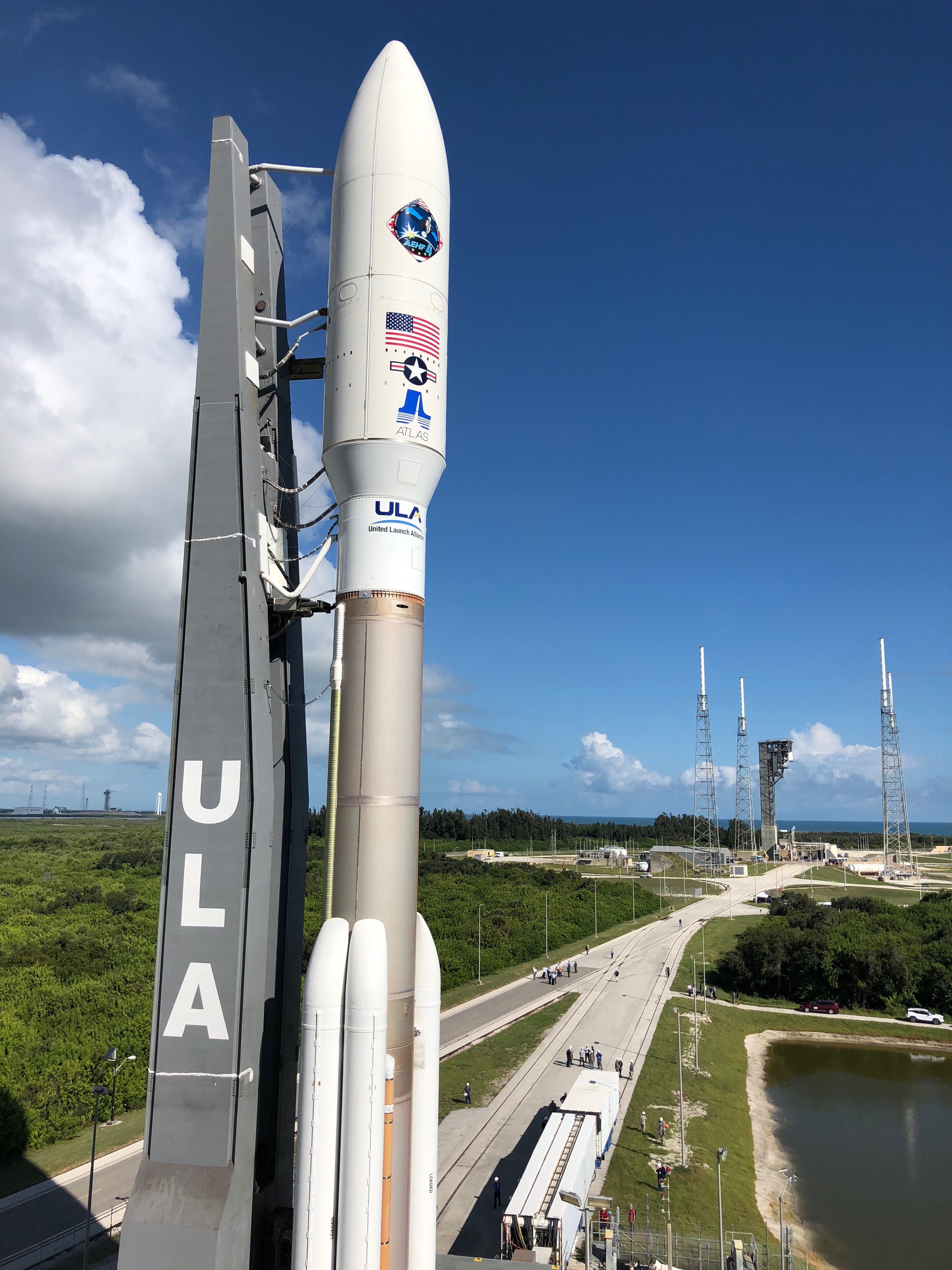
Monday @ 10:46 a.m. EDT (1446 UTC)
The Atlas V rocket is headed to the launch pad. Photo by United Launch Alliance
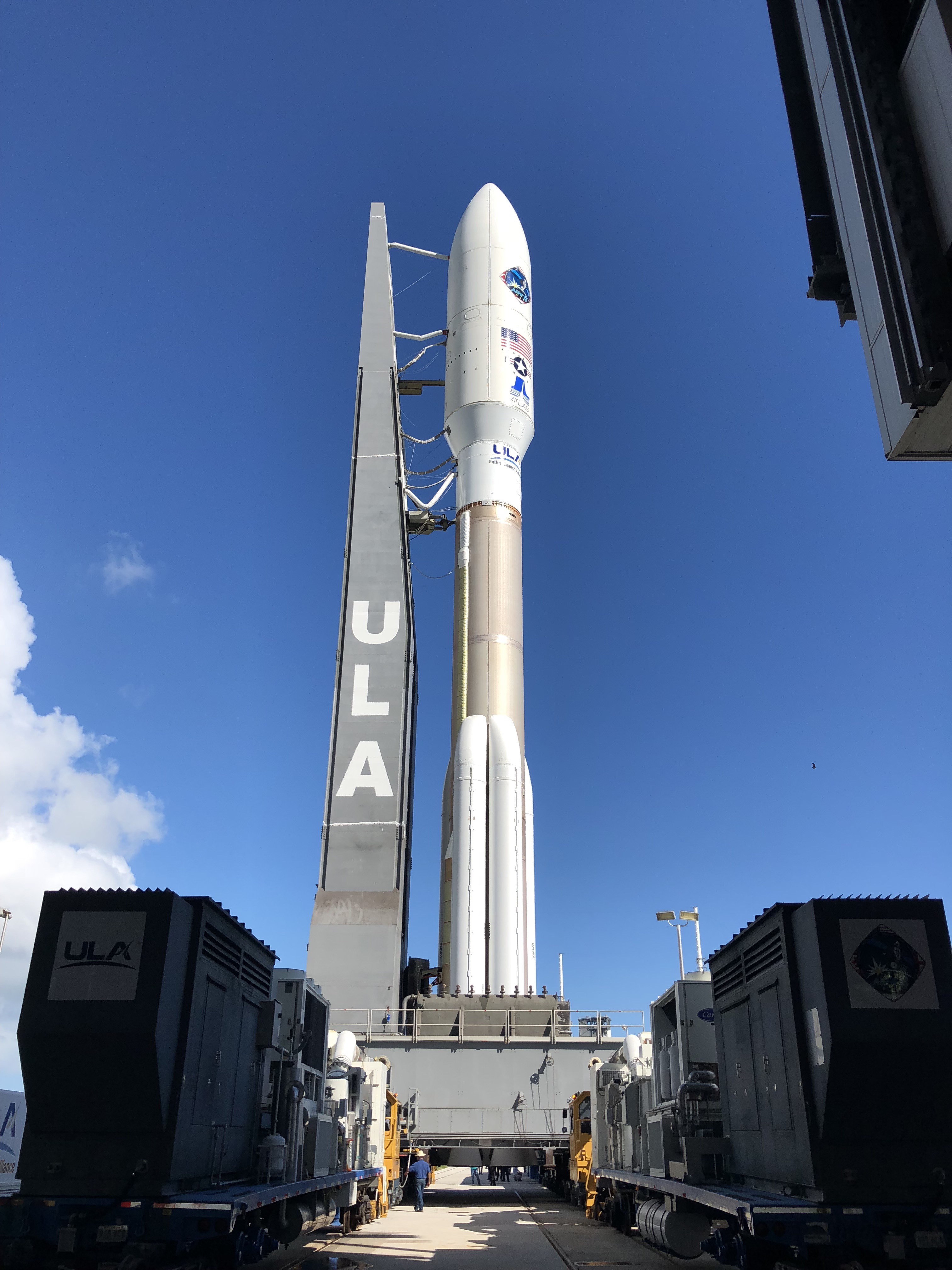
Monday @ 10:50 a.m. EDT (1450 UTC)
This launch will mark the 50th mission that United Launch Alliance has performed for the U.S. Air Force, launching communications, navigation and missile warning satellites, weather observatories and more since 2007.
More than half of the missions have used the Atlas V rocket, while others flew on Delta II and Delta IV, including the first operational Delta IV Heavy.
All but two originated from Cape Canaveral in Florida, with a pair of polar-orbiting weather craft launching from Vandenberg Air Force Base in California.
A wide range of orbits were achieved during the 49 Air Force launches so far, extending from low Earth orbit, to medium Earth orbit for the GPS constellation, transfer orbits and even direct insertion into geosynchronous orbit 22,300 miles up.
Monday @ 11:10 a.m. EDT (1510 UTC)
The Atlas V rocket has completed the first 1,800 feet on its journey into space, traveling by rail from the Vertical Integration Facility to the Space Launch Complex 41 pad for Tuesday night’s countdown to liftoff of AEHF-4, a protected communications relay station in space for the U.S. military and allies.
Over the next few hours, umbilical connections will be made with launch pad systems, the environmental control system feeding conditioned air to the rocket and payload will be switched to facility supplies to allow the portable trailers used during rollout to be unplugged and moved away, and the first stage will be loaded with 25,000 gallons of RP-1 fuel, a highly refined kerosene.
The launch countdown will begin Tuesday at 5:25 p.m. EDT (2125 UTC), leading to a liftoff nearly seven hours later at 12:15 a.m. EDT (0415 UTC) on Wednesday.
Our live countdown updates will begin on this page on Tuesday at 5:15 p.m. EDT.
The live ULA webcast of the launch begins Tuesday at 11:55 p.m. EDT and will be viewable on this page.
Photo by United Launch Alliance
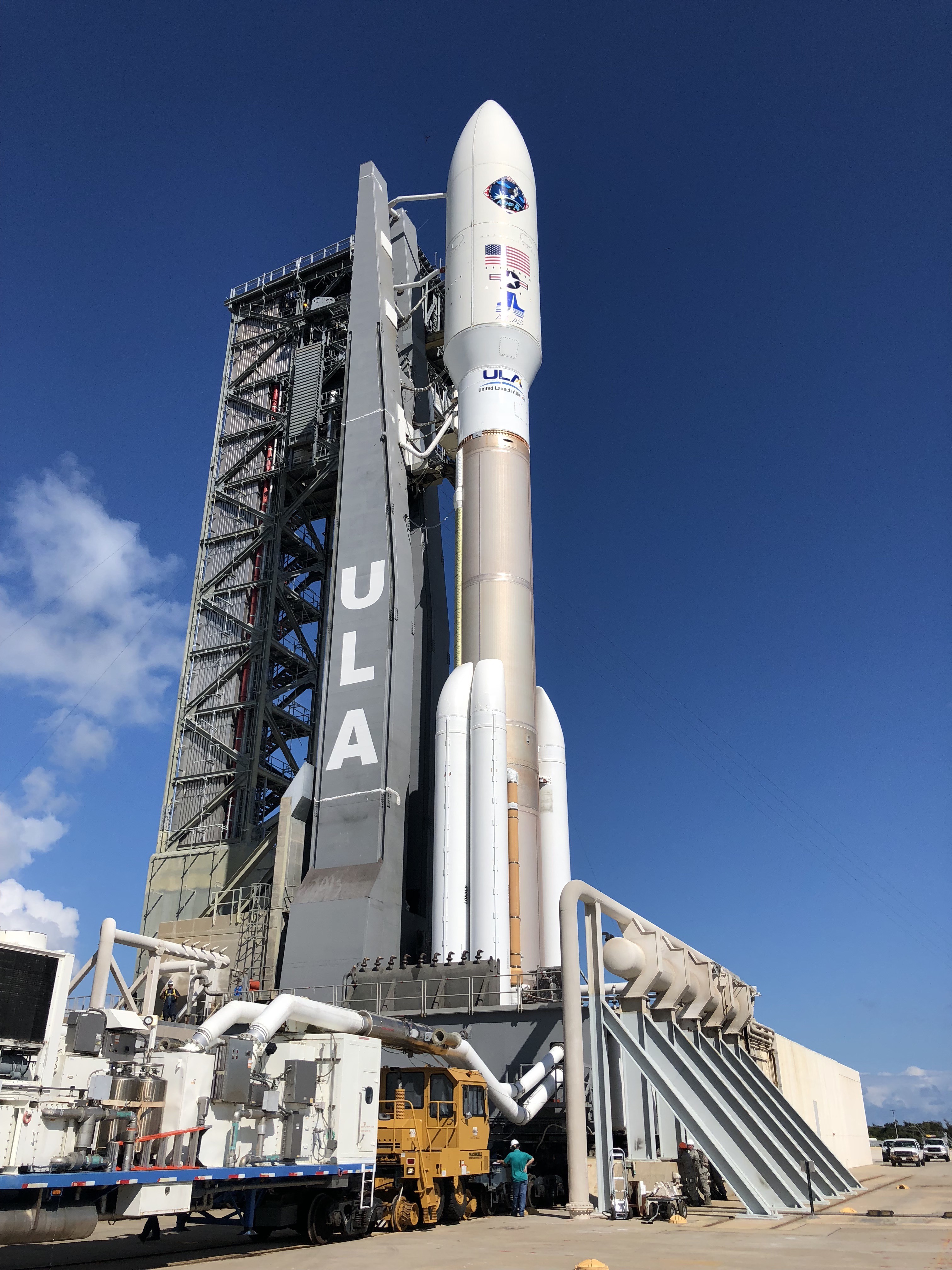
Monday @ 1:30 p.m. PDT (1730 UTC)
See our Flickr page for a collection of beautiful photos of the Atlas V rocket taken by United Launch Alliance during rollout to the pad today.
Photo by United Launch Alliance
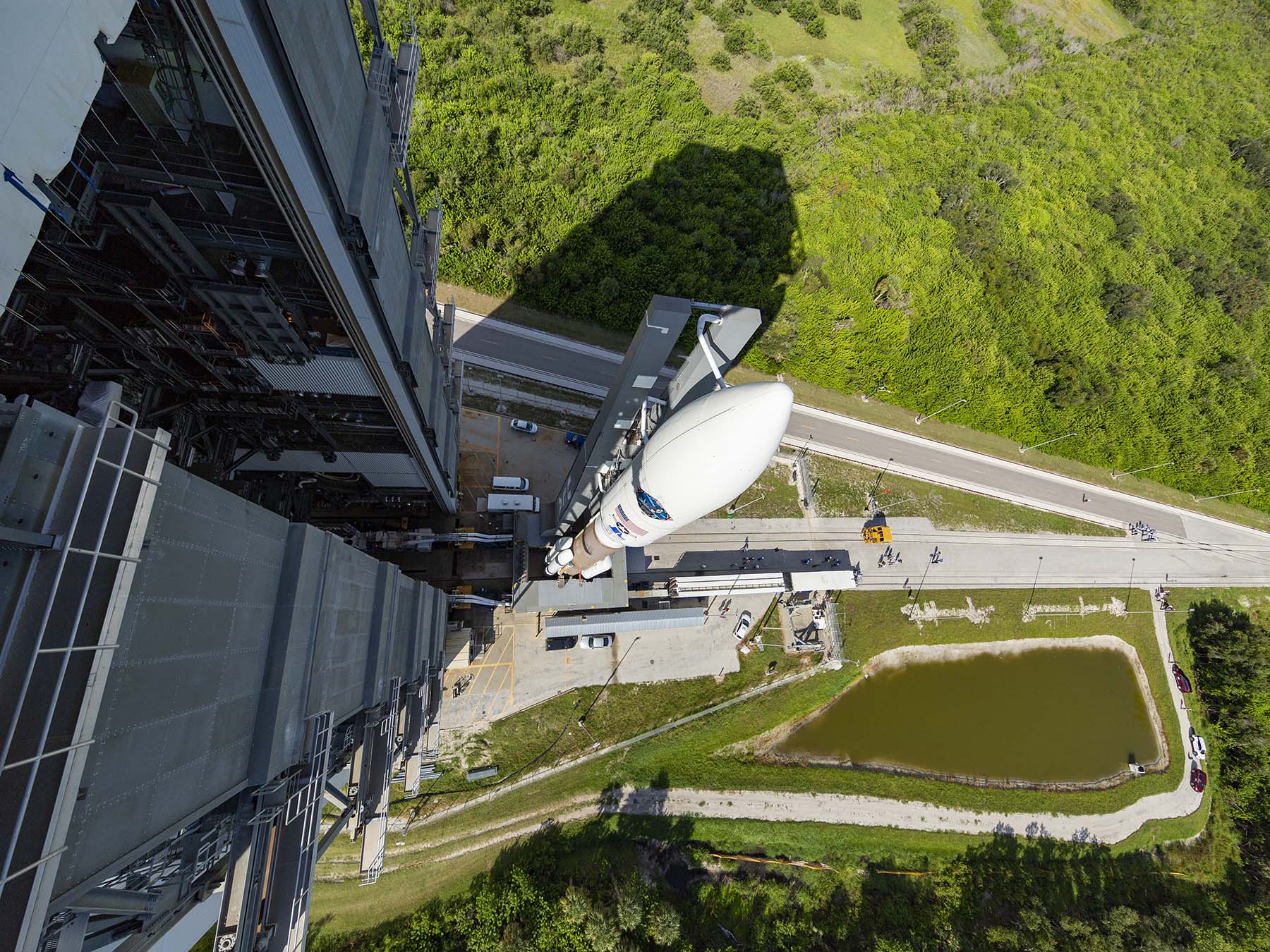
Oct. 16, 2018 @ 8:30 a.m. (1230 UTC)
Join us this evening for live reports throughout the Atlas V countdown to the AEHF-4 satellite launch. Our updates from the Atlas Spaceflight Operations Center will begin on this page at 5:15 p.m. EDT (2115 UTC), just prior to initiating the countdown.
Liftoff of the Atlas V rocket from Cape Canaveral Air Force Station in Florida is scheduled for 12:15 a.m. EDT (0415 UTC).
The official launch weather forecast from the 45th Weather Squadron continues to predict an 80 percent chance of favorable conditions at liftoff time. The outlook includes some scattered clouds, the chance of an isolated coastal shower, good visibility, southeasterly winds of 10 knots and a temperature near 80 degrees F.
See our Flickr page for nighttime photos of the Atlas V rocket on the launch pad at Cape Canaveral taken last evening by United Launch Alliance.
5:15 p.m. EDT (2115 UTC)
From the Atlas Spaceflight Operations Center at Cape Canaveral Air Force Station in Florida, this is Atlas Launch Control at T-minus 6 hours, 20 minutes and holding.
We are just seven hours away from liftoff of the United Launch Alliance Atlas V rocket with the U.S. Air Force’s Advanced Extremely High Frequency-4 spacecraft, a protected communications satellite to operate in geosynchronous orbit.
Activities are on schedule for liftoff from Space Launch Complex 41 at 12:15 a.m. EDT (0415 UTC). The launch window extends to 2:15 a.m. EDT (0615 UTC), a duration of exactly two hours.
We will be starting the countdown at 5:25 p.m.
5:25 p.m. EDT (2125 UTC) -- Countdown begins
This is Atlas Launch Control at T-minus 6 hours, 20 minutes (L-6 hours, 50 minutes) and counting.
Countdown clocks are ticking for our liftoff just after midnight tonight. There are two pre-planned, built-in holds, each lasting 15 minutes, scheduled in the count. One pause is reserved prior to fueling at T-minus 2 hours, the other occurs prior to the terminal count at T-minus 4 minutes.
The Atlas V rocket, designated AV-073, will launch AEHF-4 into a high-perigee, low-inclination elliptical geosynchronous transfer orbit. This orbit benefits the satellite by requiring less fuel to reach its final circular geosynchronous altitude 22,300 miles above the Earth, as explained in a tweet by ULA CEO Tory Bruno earlier today.
”Interesting trajectory tonight. All our orbits are customized. This is a GTO, but we will coast for several hours out to apogee and then do a major lift of the perigee. This will leave the spacecraft with only a small amount of remaining energy to add in order to circularize,” Bruno said.
It will take three hours and 33 minutes to perform this Atlas V mission, from liftoff until deployment of the AEHF-4 spacecraft, and the Centaur upper stage will perform three burns to haul the heavy payload to the optimized orbit.
Our rocket variant being flown tonight is the Atlas V 551 configuration that is distinguished by the five-meter-wide composite payload fairing, five solid rocket boosters that are side-mounted to the first stage and a single RL10C-1 engine on the Centaur upper stage. It stands 197 feet tall.
5:40 p.m. EDT (2140 UTC)
This is Atlas Launch Control and T-minus 6 hours, 5 minutes (L-6 hours, 35 minutes) and counting.
The application of power to the Atlas and Centaur stages is underway at the start of today's countdown procedures. The stages are being powered up to begin launch day testing and final preparations for fueling operations.
Over the next few hours, final preps for the liquid oxygen and liquid hydrogen systems will be performed, along with a test of the rocket's guidance system and the first stage propulsion and hydraulic preps, internal battery checks and testing of the GPS metric tracking system used to follow the rocket as it flies downrange, plus a test of the S-band telemetry relay system.
5:55 p.m. EDT (2155 UTC)
The launch team is controlling the countdown from the Atlas Spaceflight Operations Center, or ASOC, located about four miles from the launch pad, in conjunction with a team of personnel performing hands-on tasks at the Space Launch Complex 41 pad. They are being supported by customer staff stationed at Cape Canaveral’s Hangar AE, Range controllers at the Morell Operations Center and teams of engineers monitoring from ULA’s Denver Operations Support Center.
We are progressing on schedule this evening. An initial weather briefing from the Air Force launch weather officer is coming up in about an hour.
6:06 p.m. EDT (2206 UTC)
Power up of the Atlas-Centaur rocket for today's AEHF-4 launch has been accomplished. Guidance system testing is the next major milestone in the countdown as we continue tracking on schedule for liftoff at 12:15 a.m. EDT (0415 UTC). At T-minus 5 hours 39 minutes (L-6 hours, 9 minutes) and counting, this is Atlas Launch Control.
6:37 p.m. EDT (2237 UTC)
The guidance system test is beginning.
6:42 p.m. EDT (2242 UTC)
We are working no issues in the countdown. Liftoff remains scheduled for 12:15 a.m. EDT (0415 UTC).
6:54 p.m. EDT (2254 UTC) – Weather 90% GO
This is Atlas Launch Control at T-minus 4 hours, 51 minutes (L-5 hours, 21 minutes) and counting. Launch Weather Officer Jessica Williams from the Air Force's 45th Weather Squadron reports that conditions at Cape Canaveral are looking favorable for the flight of Atlas V and AEHF-4 tonight, forecasting a 90 percent chance of acceptable conditions at liftoff time.
The outlook calls for some scattered clouds, a chance of a coastal rain shower, good visibility, southeasterly winds of 10 to 12 knots and a temperature of 81 to 82 degrees F.
The only slight concern will be cumulus clouds causing a launch rule violation.
7:00 p.m. EDT (2300 UTC)
A photo of the Atlas V rocket taken a short time ago. Credit: United Launch Alliance.
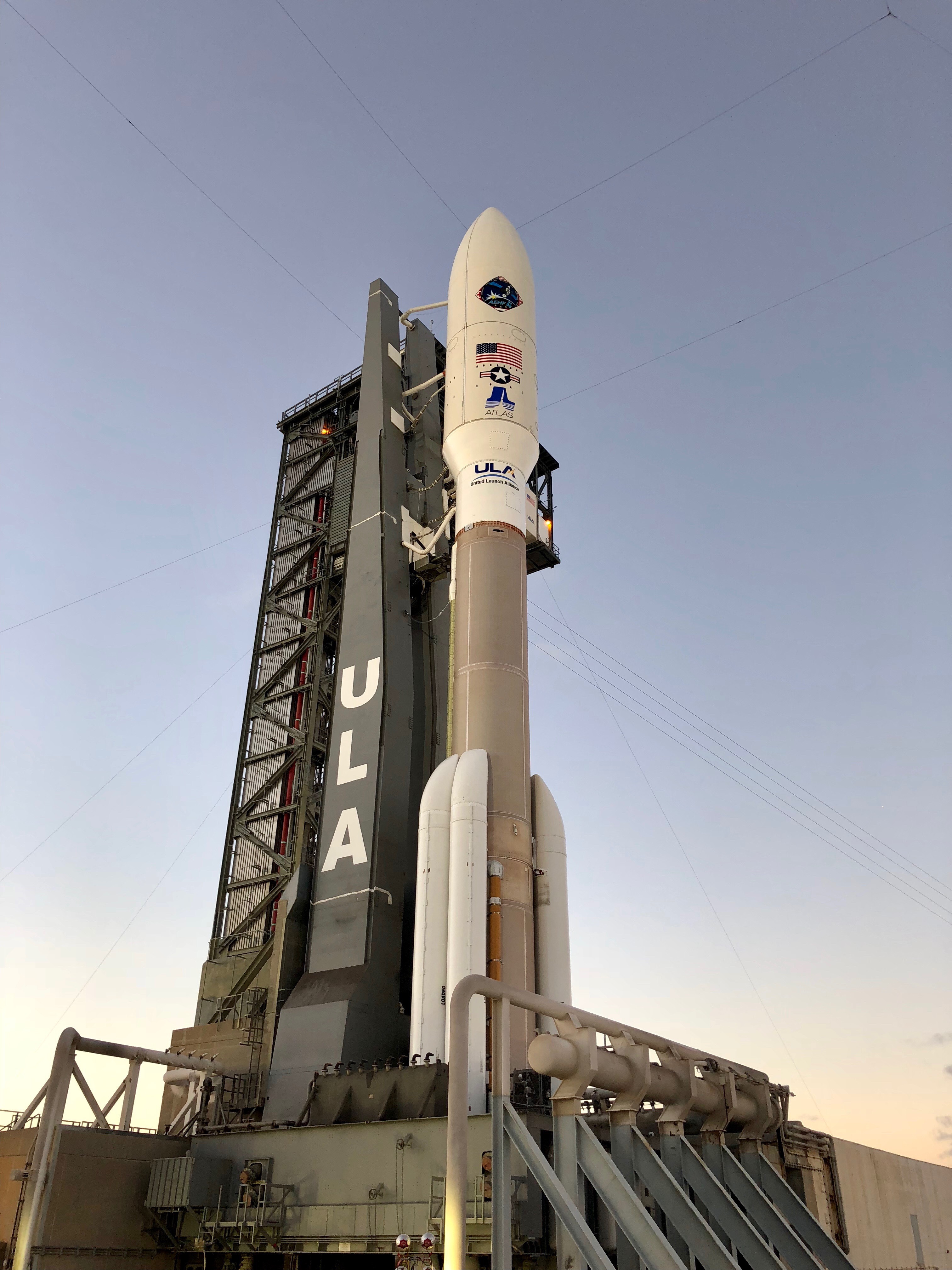
7:12 p.m. EDT (2312 UTC)
The flight control operational test is getting underway. This test will validate the control functions on the Atlas first stage main engine and the Centaur upper stage’s engine by confirming that valves cycle properly and that the engine steering systems perform as commanded.
7:25 p.m. EDT (2325 UTC)
As seen from high atop the southwest lightning protection tower at Space Launch Complex 41, the Atlas V rocket stands poised to launch AEHF-4 tonight. Credit: United Launch Alliance.
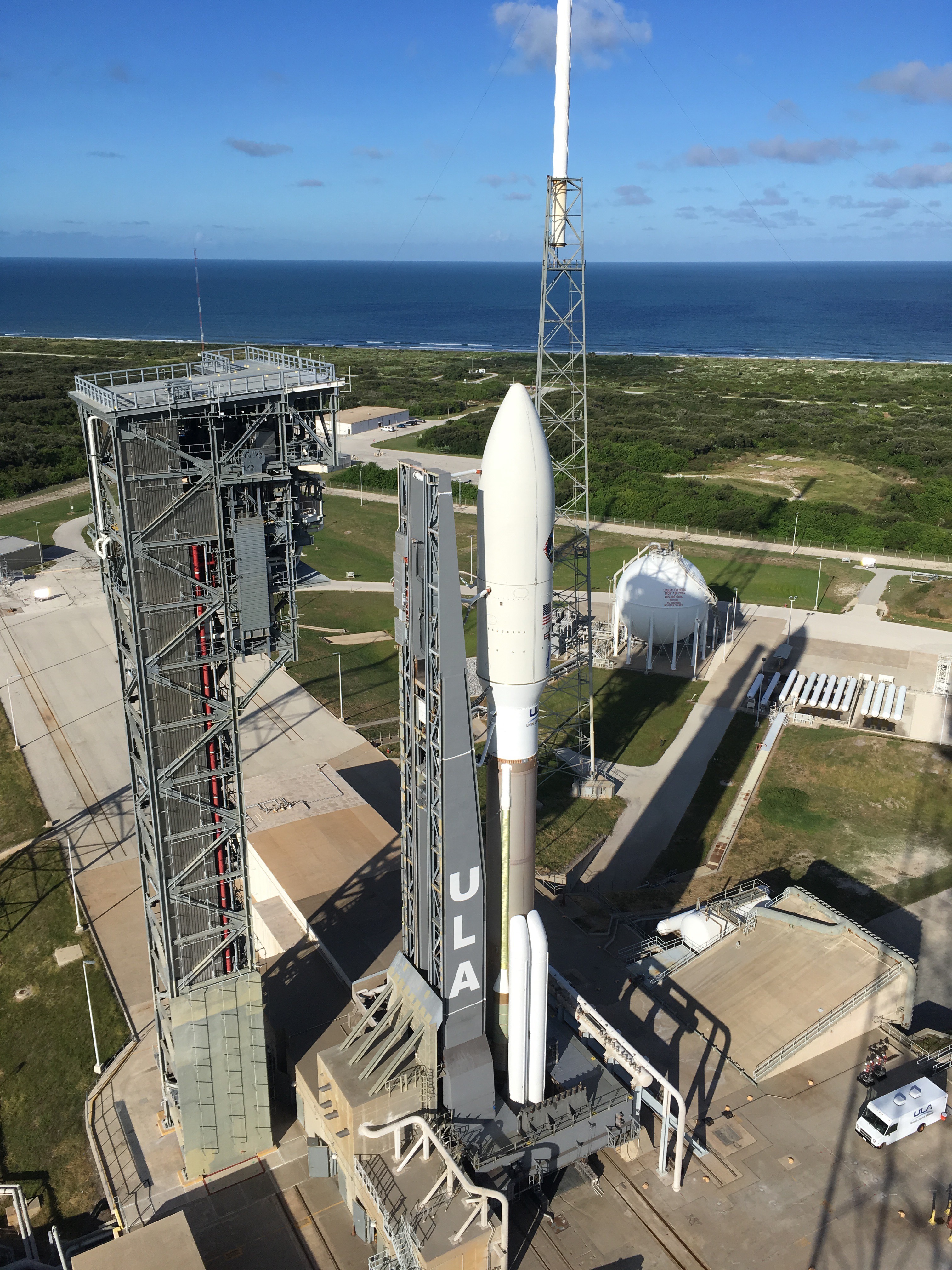
7:30 p.m. EDT (2330 UTC)
The sun has set at Cape Canaveral as our countdown continues smoothly for launch of the Atlas V rocket. Credit: United Launch Alliance.
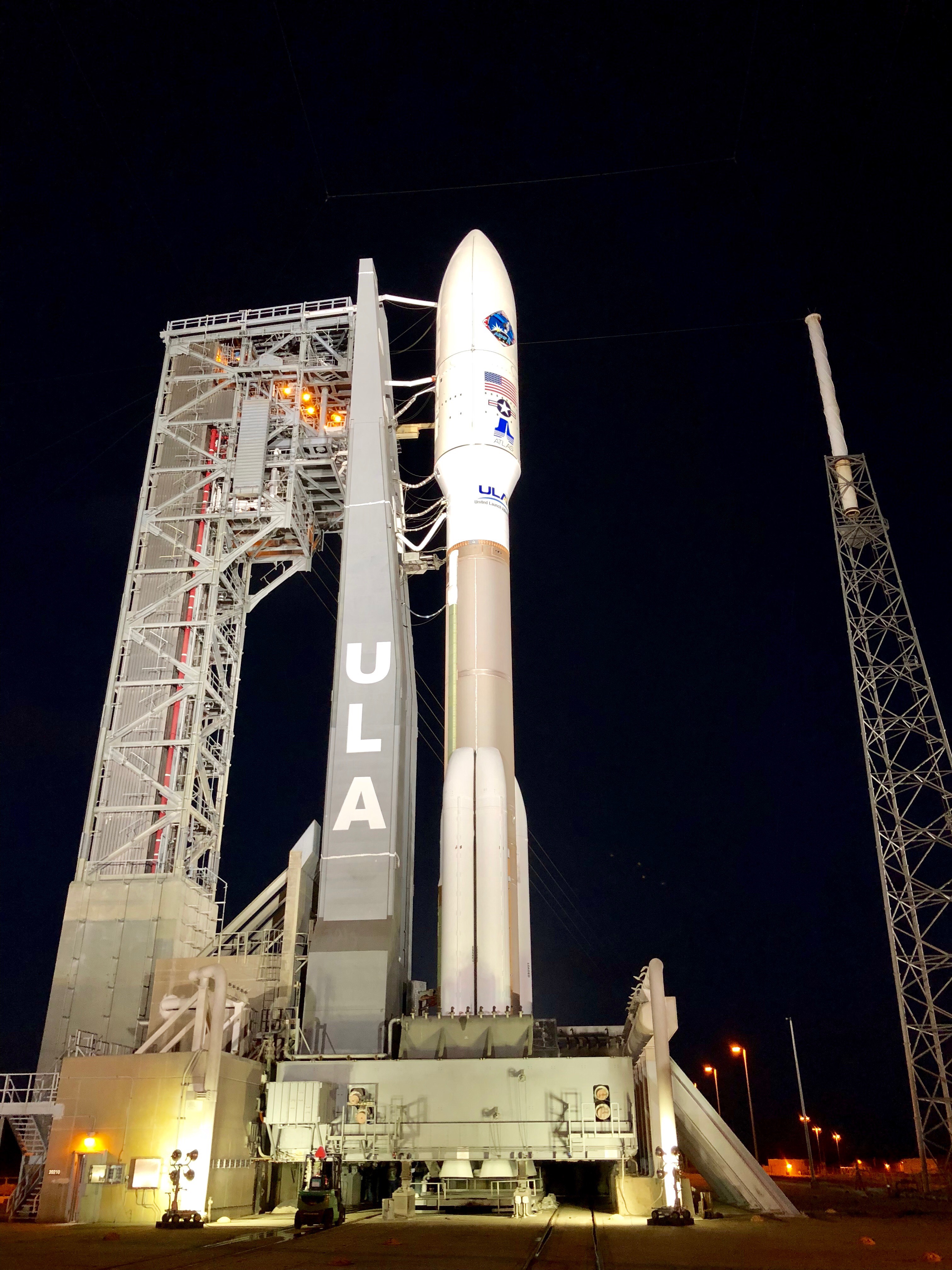
7:45 p.m. EDT (2345 UTC)
An open-loop test of the S-band system used to relay telemetry from the launch vehicle during flight is underway. Also, the GPS Metric Tracking Antenna used to follow the vehicle’s progress downrange is being checked.
8:06 p.m. EDT (0006 UTC)
Internal battery checks are beginning now.
8:15 p.m. EDT (0015 UTC)
Take a few minutes to watch highlights from the three previous AEHF satellite launches aboard United Launch Alliance Atlas V rockets from Cape Canaveral.
AEHF-1
August 2010
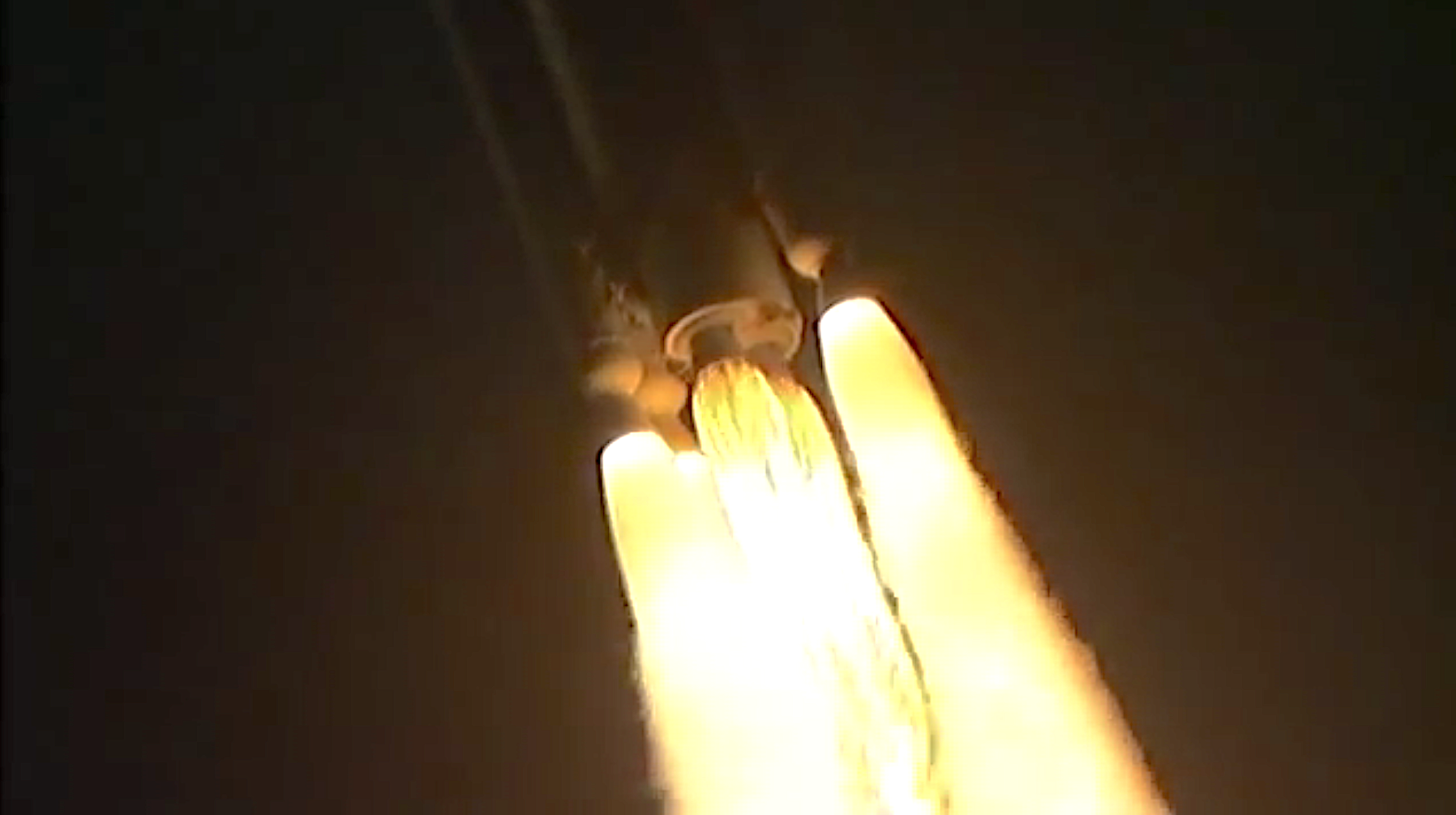
Watch
AEHF-2
May 2012
 Watch
Watch
AEHF-3
September 2013
 Watch
Watch
8:47 p.m. EDT (0047 UTC)
This is Atlas Launch Control at T-minus 2 hours, 58 minutes (L-3 hours, 28 minutes) and counting. The initiation of gaseous nitrogen flow to the launch vehicle has started. This changes the environmental control system to supply nitrogen gas rather than conditioned air to the internal compartments of the Atlas first stage, Centaur upper stage and the payload fairing in preparation for fueling and launch.
9:00 p.m. EDT (0100 UTC)
See our Flickr albums for photography of the three AEHF satellite launches aboard United Launch Alliance Atlas V.
AEHF-1
August 2010
Gallery
AEHF-2
May 2012
Gallery
AEHF-3
September 2013
Gallery
9:15 p.m. EDT (0115 UTC)
This is Atlas Launch
Control at T-minus 2 hours, 30 minutes (L-3 hours) and counting.
Countdown activities continue on schedule at the Space Launch Complex 41
pad and inside the Atlas Spaceflight Operations Center for tonight’s
Atlas V satellite-delivery mission. In the past few minutes, first stage
propulsion and hydraulic preps were reported complete. The propulsion
preps configured the ground liquid oxygen transfer system and ground
pneumatic supply systems for filling the Atlas first stage LOX tank and
pressurizing the Atlas helium bottles for launch. The hydraulic preps
configured the ground hydraulic pressure unit to provide for first stage
main engine pre-launch hydraulic control.
9:27 p.m. EDT (0127 UTC) – Weather remains 90% GO
In
the pre-fueling weather briefing to mission management, Air Force
Launch Weather Officer Jessica Williams reports that conditions remain
favorable at Cape Canaveral for a rocket countdown this evening. There
are no weather constraints against proceeding into Atlas V fueling
operations as scheduled.
The launch time forecast remains 90 percent favorable.
9:40 p.m. EDT (0140 UTC)
The launch pad crew has
completed its hands-on work to ready Space Launch Complex 41 for today’s
mission, and Launch Conductor Ed Kitta has given the instruction for
personnel to depart the site in advance of fueling operations.
9:45 p.m. EDT (0145 UTC) -- Countdown holding
This
is Atlas Launch Control at T-minus 2 hours and holding. The countdown
has entered the first of two planned, built-in holds that are scheduled
in today’s timeline. These are 15-minute blocks of time that gives the
countdown some margin to resolve issues or catch up work that could be
running late. This particular hold provides an opportunity to ensure all
is ready before fueling operations begin. The final hold occurs at
T-minus 4 minutes.
At the present time, however, all activities are on schedule and no problems are being addressed by the launch team.
9:47 p.m. EDT (0147 UTC)
The Centaur liquid oxygen
system preps have been performed to configure the ground LOX transfer
system and ground pneumatic supply systems for filling the Centaur LOX
tank and pressurizing the Centaur helium bottles for launch. Also, the
Centaur liquid hydrogen system preps have configured the ground hydrogen
transfer system for loading the Centaur hydrogen tank later in the
countdown.
9:58 p.m. EDT (0158 UTC) — Go for fueling
A
readiness poll of the launch team by Launch Conductor Ed Kitta, with
concurrence of ULA Launch Director Bill Cullen, has approved cryogenic
tanking operations to begin once the countdown resumes tonight. The
Atlas V rocket will be loaded with approximately 66,000 gallons of
liquid oxygen and liquid hydrogen over the next hour or so.
10:00 p.m. EDT (0200 UTC) -- Countdown resumes
This
is Atlas Launch Control at T-minus 2 hours (L-2 hours, 15 minutes) and
counting. The next phase of today’s launch countdown has been initiated
on schedule as we continue to target 12:15 a.m. EDT (0415 UTC) for
liftoff of the United Launch Alliance Atlas V rocket carrying the AEHF-4
communications spacecraft for the Air Force.
Preparatory steps for fueling are being kicked off, including
ground chilldown of the Atlas first liquid oxygen system and chilldown
of the transfer lines to the Centaur upper stage liquid oxygen system.
10:08 p.m. EDT (0208 UTC)
With the thermal
conditioning, or chilldown, now complete, liquid oxygen has started to
flow into the Centaur upper stage for today’s launch. About 4,150
gallons of liquid oxygen will be loaded into Centaur for its three-burn
mission to boost the AEHF-4 satellite into an optimized geosynchronous
transfer orbit.
10:17 p.m. EDT (0217 UTC)
Now 20 percent of the
Centaur LOX tank has been filled. The liquid oxygen -- chilled to
Minus-298 degrees F -- will be consumed during the launch by the
Centaur's single RL10 engine along with liquid hydrogen to be pumped
into the stage a little later in the countdown.
10:24 p.m. EDT (0224 UTC)
The Centaur liquid oxygen tank is half full.
10:29 p.m. EDT (0229 UTC)
The Centaur upper stage's liquid oxygen tank has reached the 75 percent level as filling continues.
The chilldown conditioning of liquid hydrogen propellant lines at
Space Launch Complex 41 is starting to prepare the plumbing for
transferring the Minus-423-degree F fuel into the rocket.
10:30 p.m. EDT (0230 UTC)
Filling of the Atlas V
rocket’s largest tank has begun. About 48,800 gallons of super-cold
oxidizer for the main engine is flowing into the liquid oxygen tank on
common core booster first stage.
10:44 p.m. EDT (0244 UTC)
The Centaur liquid oxygen
tank is topping to flight level. Meanwhile, first stage liquid oxygen
loading is transitioning from slow-fill to fast-fill mode.
10:50 p.m. EDT (0250 UTC)
The first stage liquid oxygen tank has reached the 20 percent mark.
10:55 p.m. EDT (0255 UTC)
The launch team has
received the "go" to begin filling the Centaur upper stage with the
super-cold fuel following chilldown of the system. The Centaur holds
about 12,300 gallons of the cryogenic propellant for its three engine
burns during this launch.
11:02 p.m. EDT (0302 UTC)
First stage liquid oxygen
tank is 50 percent full thus far. The LOX will be consumed along with
RP-1, a highly refined kerosene, by the RD-180 main engine on the first
stage during the initial four-and-a-half minutes of flight. The 25,000
gallons of RP-1 were loaded into the rocket after rollout yesterday.
11:08 p.m. EDT (0308 UTC)
Centaur's liquid hydrogen
tank is 50 percent full. The cryogenic propellant will be consumed with
liquid oxygen by the stage's Aerojet Rocketdyne RL10C-1 engine.
11:14 p.m. EDT (0314 UTC)
The liquid hydrogen tank in the Centaur upper stage just reached the 96 percent level. Topping is beginning.
11:15 p.m. EDT (0315 UTC)
This is Atlas Launch
Control with 60 minutes remaining in our countdown to liftoff at 12:15
a.m. EDT (0415 UTC). Today marks the 79th flight for Atlas 5 since
debuting in August 2002. The vehicle has a 100 percent mission success
record for the Defense Department, NASA, the National Reconnaissance
Office and commercial customers.
11:25 p.m. EDT (0325 UTC)
Fast-filling of the first
stage liquid oxygen tank has been completed. Topping mode is now
underway to give us a fully-fueled, 1.3-million-pound rocket for flight.
The cryogenics will be replenished throughout the countdown until the
final minutes before launch to replace the liquid oxygen and liquid
hydrogen that naturally boils away.
11:30 p.m. EDT (0330 UTC)
This launch uses the 551 version of the Atlas V rocket, generating the necessary power to deliver the Advanced Extremely High Frequency-4 payload to an optimized geosynchronous transfer orbit.
This configuration of the Atlas V is distinguished by two stages, a five-meter-wide nose cone, five side-mounted solid-fuel boosters and a single-engine Centaur upper stage.
The United Launch Alliance Atlas V rocket will come off the pad on 2.6 million pounds of thrust produced by the RD-180 main engine and five solids.
Today's version stands 197 feet tall.
The 551 has flown 8 times before, including the deployments of NASA’s New Horizons probe to Pluto, the Juno orbiter to Jupiter and the Navy’s constellation of five MUOS mobile communications satellites and earlier this year with the AFSPC-11 mission direct to geosynchronous orbit.
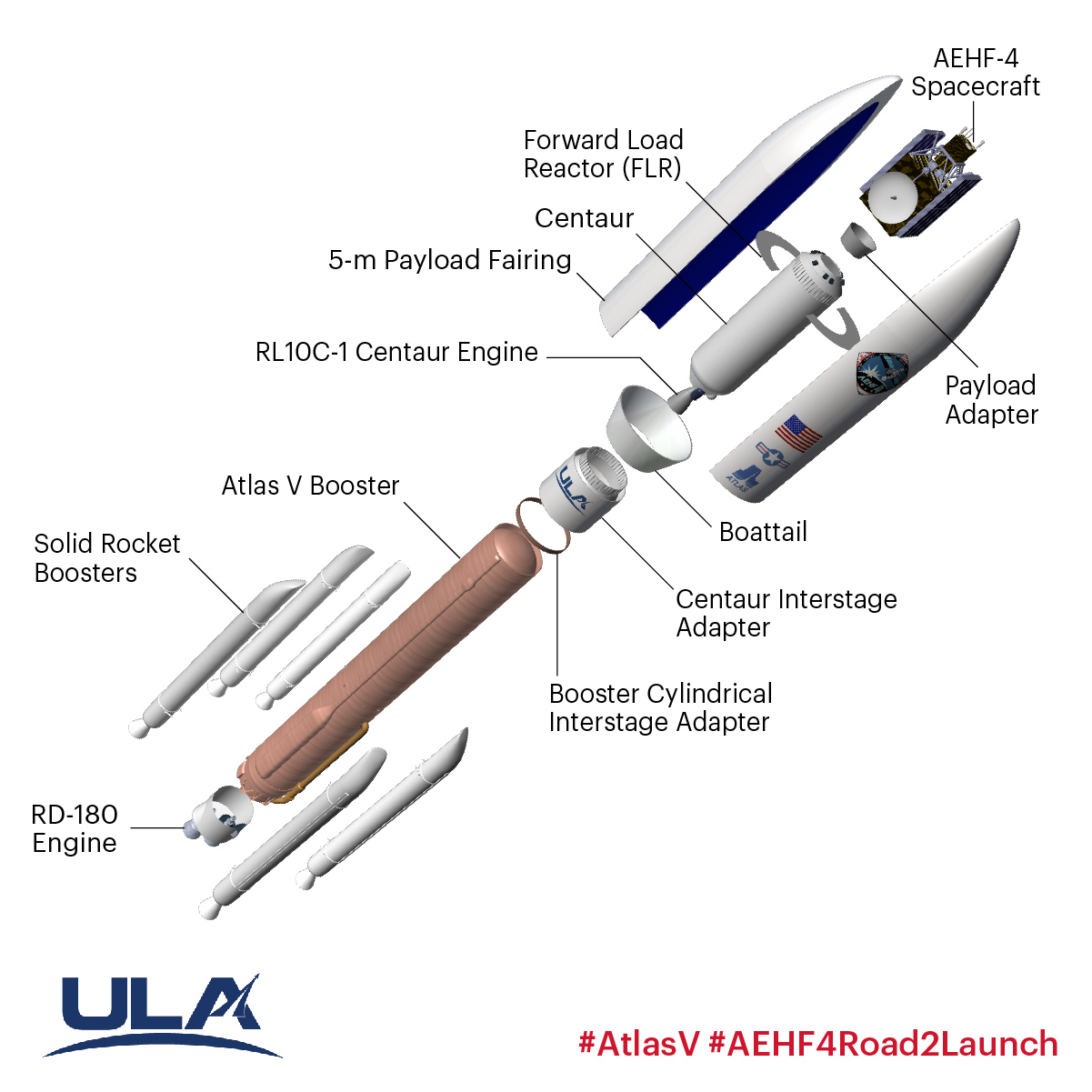
11:35 p.m. EDT (0335 UTC)
United Launch Alliance will use the
Atlas V 551 rocket tonight to launch the fourth communications
satellite in the Advanced Extremely High Frequency (AEHF) series for the
U.S. Air Force.
AEHF spacecraft are nuclear-hardened satellites to ensure
survivable, highly-secure connectivity between U.S. national leadership
and deployed military forces, routing vital communications such as
real-time video, battlefield maps and targeting data in both peacetimes
and during a war.
Atlas V rockets successfully launched the first AEHF satellite in
2010, AEHF-2 in 2012 and AEHF-3 in 2013 as the new constellation was
formed in geosynchronous orbit 22,300 miles above Earth to augment and
eventually replace the heritage MILSTAR satellite fleet.
AEHF-4 will be delivered into an optimized high-perigee,
low-inclination geosynchronous transfer orbit following a
three-and-a-half hour ascent that includes three burns by the Centaur
upper stage. This orbit benefits the satellite by requiring less fuel to
reach its final geosynchronous altitude.
This newest satellite will give the AEHF system full global
coverage to support U.S. and allied warfighters on land, at sea and in
the air. AEHF-4 ensures worldwide Extended Data Rate (XDR) protected
communications, offering 10 times more communications throughput than
the legacy MILSTAR constellation.
11:44 p.m. EDT (0344 UTC)
The fuel fill sequence is
beginning. This procedure releases RP-1 kerosene fuel into the RD-180
main engine in preparation for ignition.
11:46 p.m. EDT (0346 UTC)
Weather is observed and
forecast GO for liftoff at 12:15 a.m. EDT (0415 UTC) today, according to
the countdown’s final planned briefing by Air Force weather officer
Jessica Williams.
11:53 p.m. EDT (0353 UTC)
United Launch Alliance’s live video broadcast of today’s liftoff is about to begin in the embedded YouTube stream on this page.
11:54 p.m. EDT (0354 UTC)
The AEHF-4 spacecraft is switching from ground-fed power to its internal batteries for launch.
11:56 p.m. EDT (0356 UTC) -- Countdown holding
T-minus
4 minutes and holding. The countdown has entered the planned 15-minute
built-in hold designed to give a bit of margin to deal with any
problems. Also during this time, the final readiness polls of the launch
team and management members will be performed.
We remain on schedule for a liftoff at 12:15 a.m. EDT (0415 UTC) from Space Launch Complex 41 at Cape Canaveral.
In the countdown, we have completed the fuel fill sequence to
ready the first stage main propulsion system for launch. And all three
cryogenic tanks on the rocket have been topped off to flight level.
Oct. 17, 2018 @ 12:00 a.m. EDT (0400 UTC)
The fully fueled Atlas V 551 rocket stands 197 feet tall and weighs 1.3 million pounds.
The AEHF-4 spacecraft, built on Lockheed Martin’s A2100 satellite
design, will have a wingspan of 89 feet once the power-generating solar
arrays are deployed in space.
12:03 a.m. EDT (0403 UTC)
This is Atlas Launch Control at T-minus 4 minutes and holding. All of the communications loops are quiet at the present time during this hold. The countdown remains on target for liftoff at 12:15 a.m. EDT (0415 UTC) when today's 120-minute launch opportunity opens.
Coming off the pad on 2.6 million pounds of thrust from the combined power of the kerosene-fueled first stage main engine and all five solid boosters, the rocket will perform pitch, yaw and roll maneuvers to align with a due east heading along a flight azimuth of 90.7 degrees.
The vehicle will hit Mach 1, the speed of sound, in 35 seconds and pass through Max Q, the region of maximum dynamic pressure, at 48 seconds.
The solid boosters will burn out and separate in less than two minutes. The payload fairing that protected the satellite during atmospheric ascent will be jettisoned at the edge of space three-and-a-half minutes into flight.
Cutoff of the main engine and staging occurs four-and-a-half minutes after launch, allowing the cryogenic Centaur upper stage to ignite for a 7-minute initial burn to reach a preliminary parking orbit. A brief 11-minute coast through space sets up the Centaur to perform another 6-minute burn that accelerates the payload into a highly elliptical intermediate orbit.
Centaur then goes into its long-duration coast mode for nearly three hours to reach the high end of the orbit. A third firing of the RL10 engine, lasting more than a minute-and-a-half, will raise the orbit’s low point and reduce inclination relative to the equator.
Spacecraft separation is expected at T+plus 3 hours and 33 minutes in an optimized orbit with an apogee of 19,060 nautical miles, a perigee of 4,813 miles and inclination of 12.8 degrees. ULA and the AEHF program produced this ascent profile to maximize mission flexibility over the satellite’s lifetime.
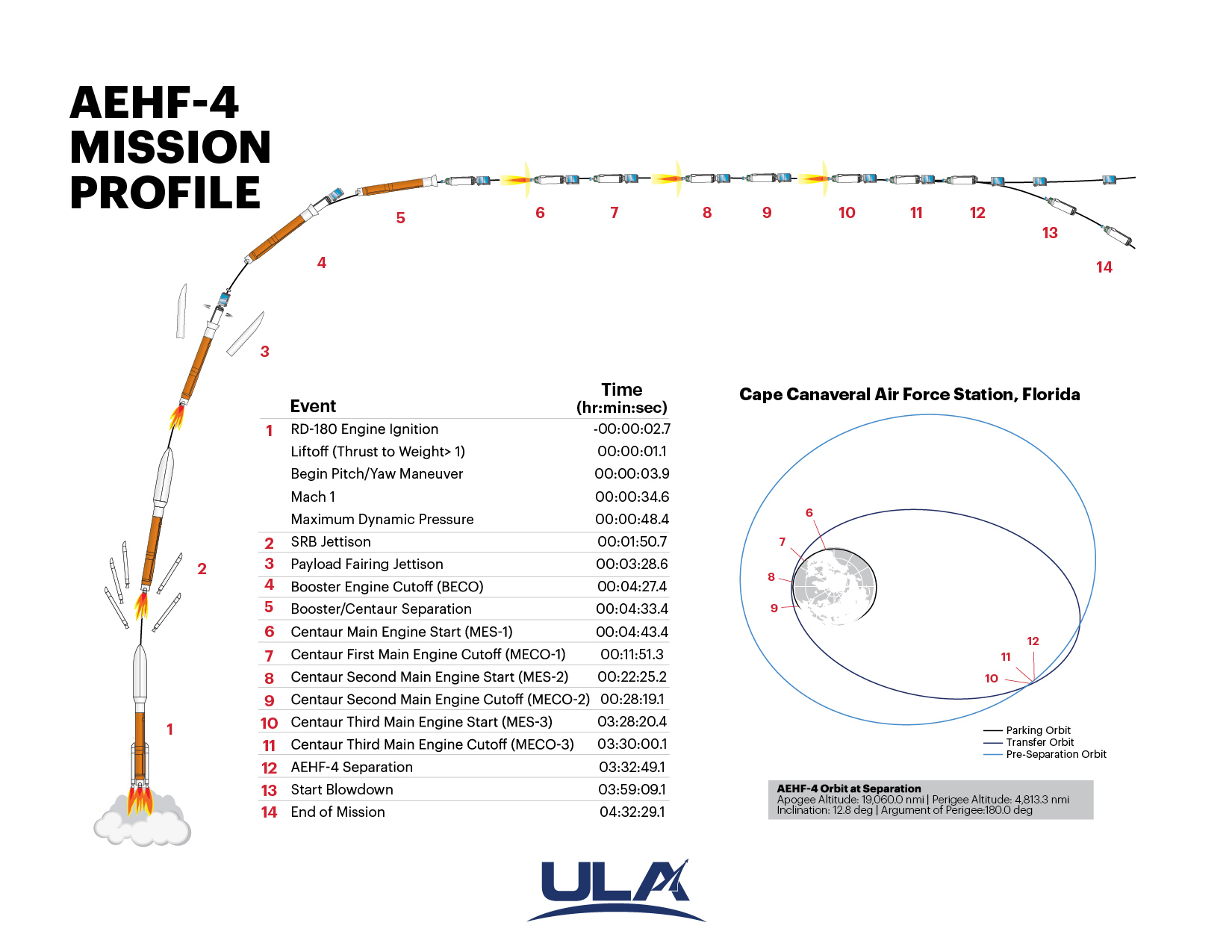
12:07 a.m. EDT (0407 UTC)
We are standing by for the
readiness poll to proceed with the terminal count. Launch Conductor Ed
Kitta will poll engineers and managers for the "go" to fly today.
12:09 a.m. EDT (0409 UTC) -- GO for launch!
The ULA
Launch Director Bill Cullen and Air Force Mission Director Michael Dolan
have given their respective final approvals to resume the countdown for
flight of Atlas V to deliver AEHF-4 into space. Their concurrence was
made following the readiness poll of the launch team by Launch Conductor
Ed Kitta that verified all systems are "go" for launch.
12:11 a.m. EDT (0411 UTC) -- Countdown resumes
T-minus
4 minutes and counting. The final phase of today’s countdown is
underway at Cape Canaveral to launch the Atlas V rocket and AEHF-4
payload for the U.S. Air Force. The countdown clocks have resumed,
leading us to a 12:15 a.m. EDT (0415 UTC) liftoff.
Over the next minute, the ground pyrotechnics will be enabled and
the Atlas first stage liquid oxygen replenishment secured so that the
tank can be pressurized for launch.
12:13 a.m. EDT (0413 UTC)
T-minus 1 minute, 55
seconds. The launch sequencer has been started. It will perform
independent verifications of systems for the rest of the countdown,
control the detachment of umbilicals from the vehicle and release the
rocket from the pad at liftoff.
The first stage RP-1 kerosene fuel and the liquid oxygen tanks
have stepped up to proper pressure levels for flight and the Atlas and
Centaur stages have switched from ground power to internal batteries.
In the next few seconds, the liquid oxygen and liquid hydrogen
propellant topping to the Centaur upper stage will be secured and the
tanks go be confirmed stable at flight pressures. Also, the rocket's
ordnance controller and the vehicle safety system will be armed. The
flight software on the vehicle will go active at T-minus 80 seconds and
issue the command at T-minus 5 seconds to start the main engine.
12:14 a.m. EDT (0414 UTC)
T-minus 55 seconds. The Air Force’s Eastern Range at Cape Canaveral has verified its “green” condition for launch.
Coming up at T-minus 25 seconds, a final status check will be announced on Atlas, Centaur and AEHF-4 readiness.
The RD-180 will roar to life at T-minus 2.7 seconds. Once the
engine ready indication is received, the solid rocket boosters will
light and hold down bolts fired to release the vehicle from the pad for
liftoff at T+plus 1.1 seconds.
12:15 a.m. EDT (0415 UTC) -- LIFTOFF!
Liftoff of the
United Launch Alliance Atlas V rocket launching the AEHF-4 spacecraft
to relay protected communications for U.S. national security!
12:16 a.m. EDT (0416 UTC)
T+plus 60 seconds into
this midnight ride to orbit for the Air Force’s fourth Advanced
Extremely High Frequency military communications satellite.
The Atlas V performed its pitch, yaw and roll maneuvers off the
launch pad to achieve the proper heading with a due east azimuth of 90.7
degrees, broke through the sound barrier to go supersonic and passed
the period of maximum aerodynamic stresses in the lower atmosphere.
12:16 a.m. EDT (0416 UTC)
T+plus 1 minute, 50
seconds. Solid rocket booster burnout and jettison is confirmed. All
five of the Aerojet Rocketdyne-made solid rocket motors have
successfully separated from the Atlas V first stage, having completed
their job of adding a powerful kick at liftoff.
12:17 a.m. EDT (0417 UTC)
T+plus 2 minutes. The
Atlas V has reached Mach 5 as the vehicle continues to accelerate on the
thrust from its RD-180 main engine.
12:18 a.m. EDT (0418 UTC)
T+plus 3 minutes. The
Atlas V weighs just a quarter of what it did at liftoff three minutes
ago. The vehicle remains on course with its main engine powering the
flight downrange. Engine operating parameters are reported nominal as
the RD-180 burns a mixture of highly refined kerosene and liquid oxygen.
12:18 a.m. EDT (0418 UTC)
T+plus 3 minutes, 40
seconds. Payload fairing jettison is confirmed from the edge of space.
The two-halves of the RUAG Space-made composite shroud have separated to
expose the satellite after ascent through the atmosphere. Also, the
Centaur Forward Load Reactor, a two-piece deck that rings the upper
stage to support the fairing during launch, has separated as planned.
12:19 a.m. EDT (0419 UTC)
T+plus 4 minutes, 49
seconds. Successful staging and ignition of the Centaur upper stage is
confirmed. The vehicle now weighs just five percent of its liftoff mass.
The first stage of flight was completed with booster engine
cutoff, or BECO, followed by separation of the Atlas V’s common core
booster.
That enabled the Centaur’s RL10C-1 engine to begin the first of
three planned firings this morning to deliver AEHF-4 to the desired
orbit.
12:21 a.m. EDT (0421 UTC)
T+plus 6 minutes. The RL10
engine is performing well with good operating parameters reported. This
first burn by Centaur will last six minutes to place the vehicle into
an initial parking orbit around the Earth.
12:21 a.m. EDT (0421 UTC)
T+plus 6 minutes, 30 seconds. A look at first stage performance numbers show a nominal burn by the common core booster.
12:23 a.m. EDT (0423 UTC)
T+plus 8 minutes, 45
seconds. The Centaur continues firing to obtain orbital velocity,
burning liquid hydrogen and liquid oxygen propellants, and the telemetry
of system status looks good. The rocket has performed a planned roll to
improve antenna links with NASA's orbiting Tracking and Data Relay
Satellite System.
12:25 a.m. EDT (0425 UTC)
T+plus 10 minutes. Atlas V
remains on course, flying eastward across the Atlantic Ocean. Less than
two minutes remain in this first Centaur burn.
12:27 a.m. EDT (0427 UTC)
T+plus 12 minutes. The
first main engine cutoff, or MECO-1, is confirmed for the Centaur upper
stage. The vehicle has reached a preliminary Earth orbit where it will
coast above the Central Atlantic for the next 11 minutes before the next
burn begins.
12:30 a.m. EDT (0430 UTC
T+plus 15 minutes. The first burn by Centaur inserted the rocket into the precise target orbit as planned.
12:32 a.m. EDT (0432 UTC)
T+plus 17 minutes. Now half-way through this coast period, Centaur systems remain stable.
12:37 a.m. EDT (0437 UTC)
T+plus 22 minutes, 32
seconds. Ignition! The Centaur's single RL10C-1 engine has re-ignited to
climb from its initial parking orbit into a highly elliptical orbit on
the way to the optimized geosynchronous transfer orbit later this
morning.
12:39 a.m. EDT (0439 UTC)
T+plus 24 minutes. This
six-minute firing by Centaur, the second of three burns during the
launch, is progressing well, according to nominal system parameters
streaming back from the Atlas V rocket.
12:41 a.m. EDT (0441 UTC)
T+plus 26 minutes. The
Aerojet Rocketdyne RL10C engine continues to deliver the thrust to raise
the high point, or apogee, of the rocket’s orbit to nearly the height
of the geosynchronous belt.
12:42 a.m. EDT (0442 UTC)
T+plus 27 minutes, 30 seconds. About one minute remains in the burn.
12:43 a.m. EDT (0443 UTC)
T+plus 28 minutes, 27
seconds. The second main engine cutoff, or MECO-2, is confirmed for
Centaur, completing the next step towards the targeted orbit to deploy
AEHF-4. The rocket now begins a three-hour coast away from Earth to
reach the proper point in space for the morning’s third burn by the
upper stage to optimize the orbit for payload release.
12:45 a.m. EDT (0445 UTC)
The Atlas V rocket lifted off at 12:15 a.m. EDT (0415 UTC) carrying the AEHF-4 spacecraft. Photo by United Launch Alliance.
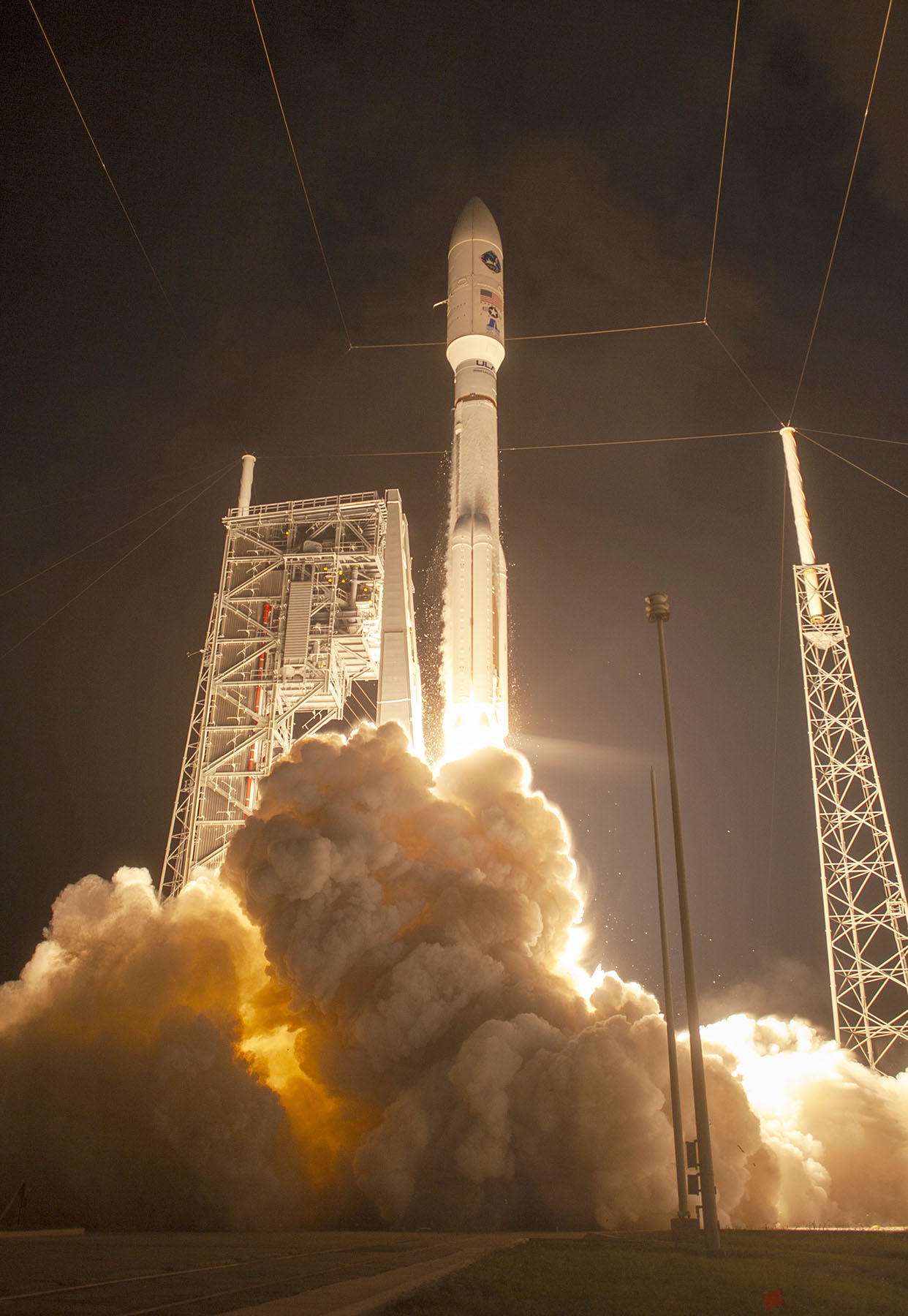
12:46 a.m. EDT (0446 UTC)
T+plus 31 minutes. The second burn by Centaur achieved the targeted orbit as planned.
12:47 a.m. EDT (0447 UTC)
T+plus 32 minutes. While our live webcast is concluding, this Live Launch Blog will continue through completion of the mission.
12:55 a.m. EDT (0455 UTC)
T+plus 40 minutes. This is
Atlas Launch Control. To recap, the United Launch Alliance Atlas V 551
rocket lifted off on time at 12:15 a.m. EDT (0415 UTC) carrying the
fourth Advanced Extremely High Frequency (AEHF-4) communications
satellite for the U.S. military from Cape Canaveral, Florida.
Following the first stage of flight, the Centaur upper stage
performed an initial burn that achieved a parking orbit. A second burn
then injected the rocket and payload into an intermediate orbit.
We’re now in the midst of a three-hour coast away from Earth
before the third and final burn occurs to reach an optimized
geosynchronous transfer orbit that is advantageous for the satellite to
conserve its onboard fuel supply during final positioning in space.
1:00 a.m. EDT (0500 UTC)
The Atlas V rocket heads to space from Cape Canaveral today. Photo by United Launch Alliance.
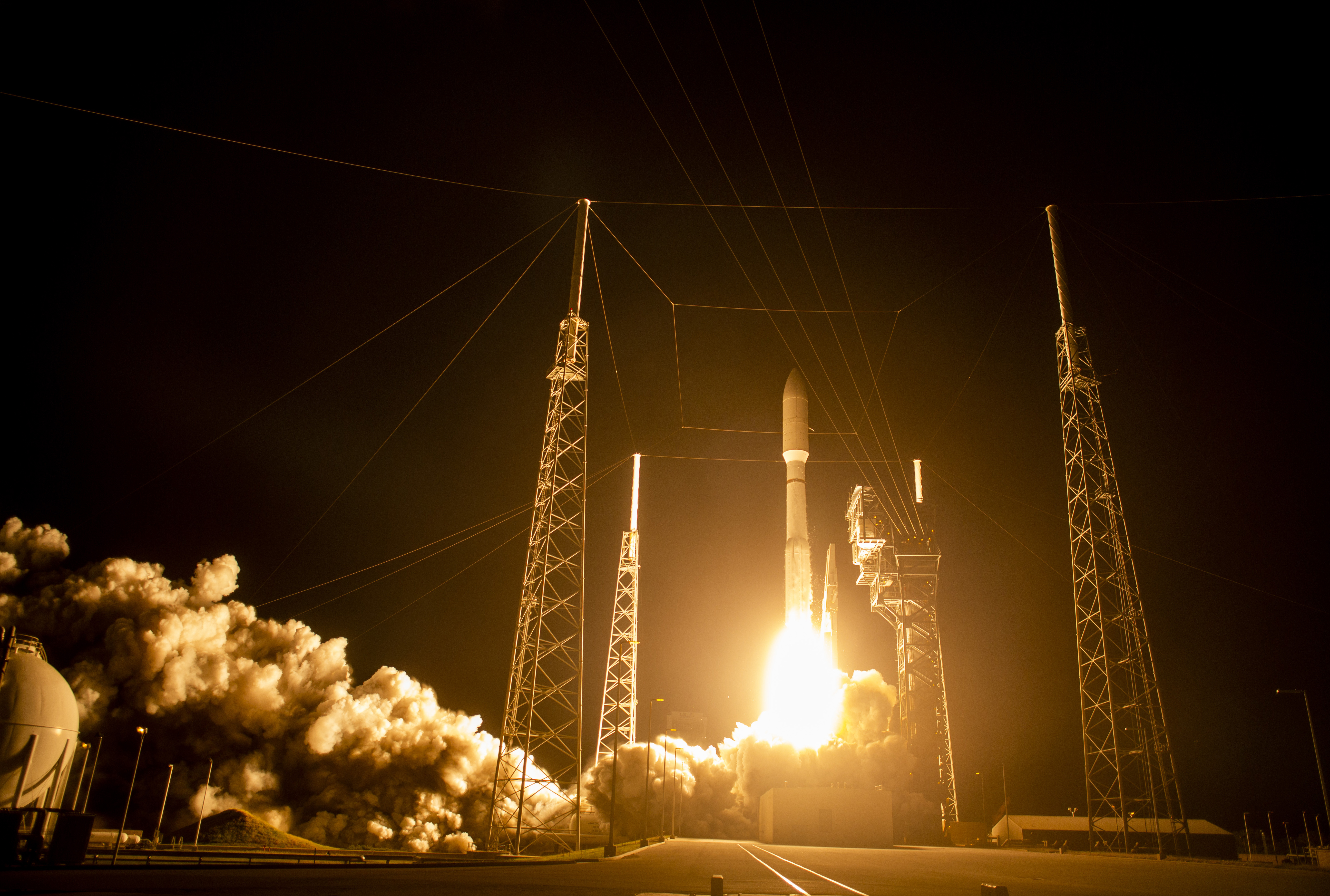
1:15 a.m. EDT (0515 UTC)
The Atlas V rocket launches on United Launch Alliance's 50th mission for the U.S. Air Force. Photo by United Launch Alliance.
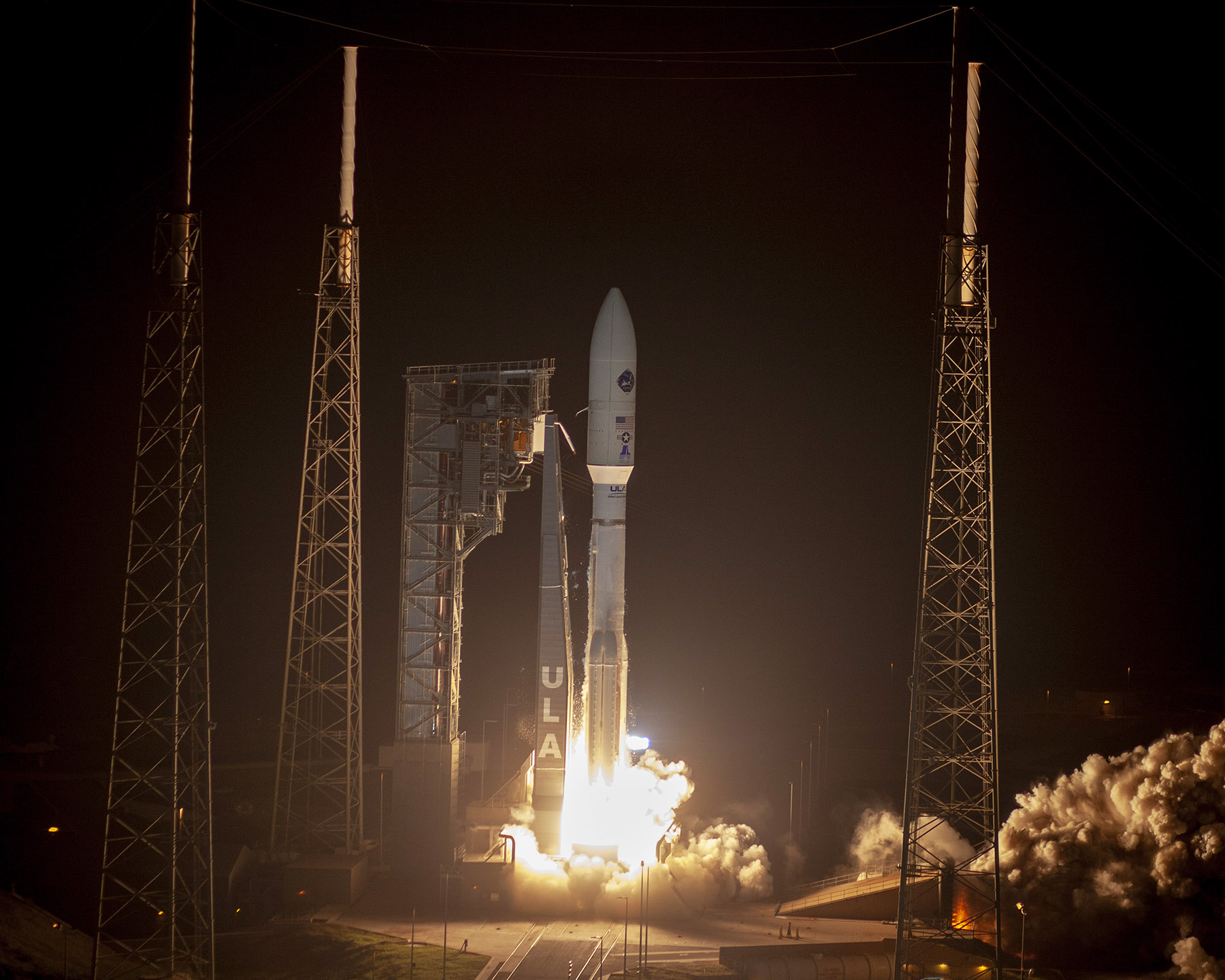
1:30 a.m. EDT (0530 UTC)
T+plus 1 hour, 15 minutes. Centaur continues to coast away from the Earth in this intermediate orbit. Stage systems are reported nominal as the rocket performs a slow roll to keep the solar heating evenly distributed on all surfaces.
1:45 a.m. EDT (0545 UTC)
This view of today’s Atlas V launch was taken from the nearby Space Launch Complex 37, the Delta IV rocket’s East Coast home at Cape Canaveral. Photo by United Launch Alliance.
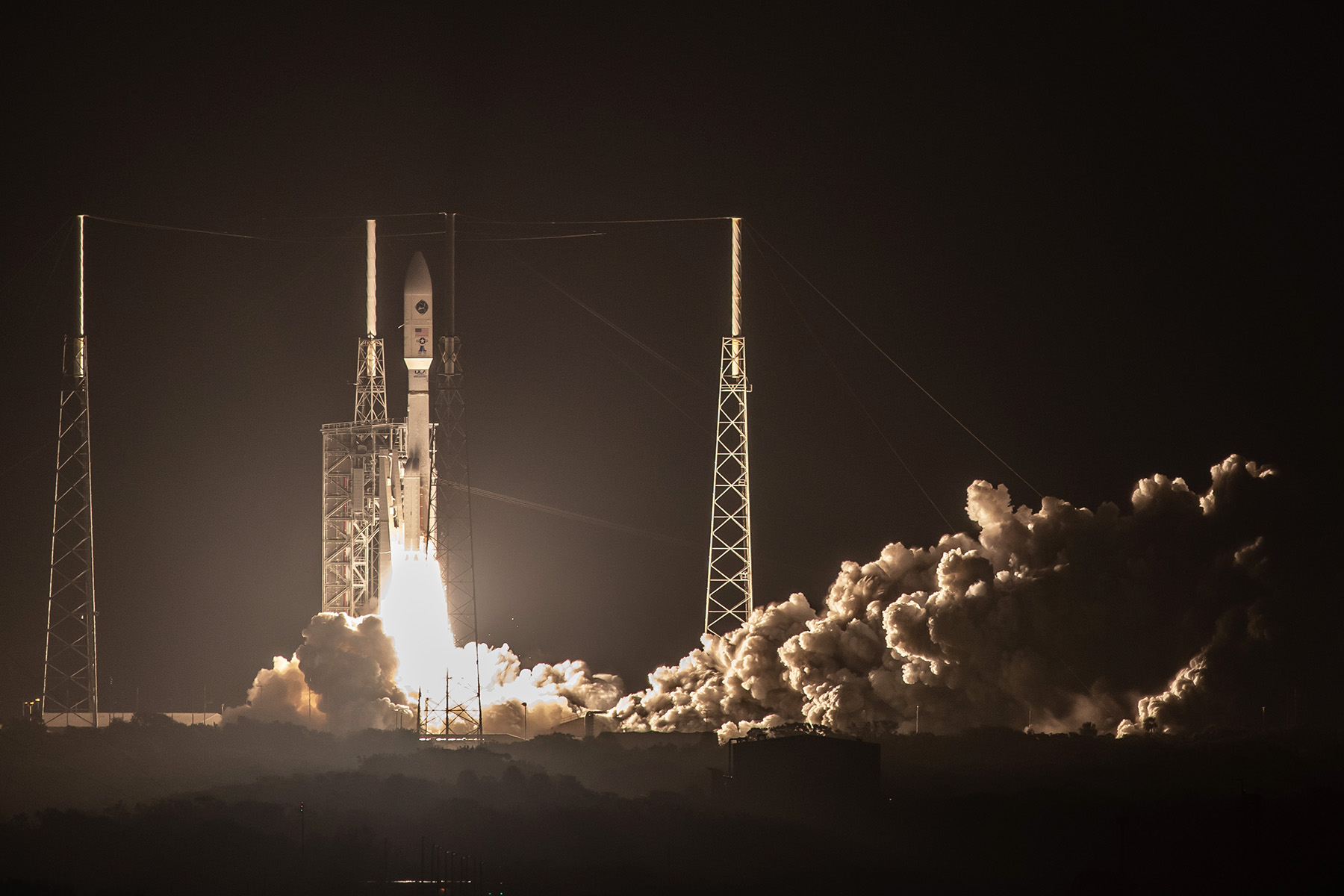
2:00 a.m. EDT (0600 UTC)
T+plus 1 hour, 45 minutes. Centaur continues to coast smoothly.
2:15 a.m. EDT (0615 UTC)
Today’s launch is the 79th flight of Atlas V. Photo by United Launch Alliance.
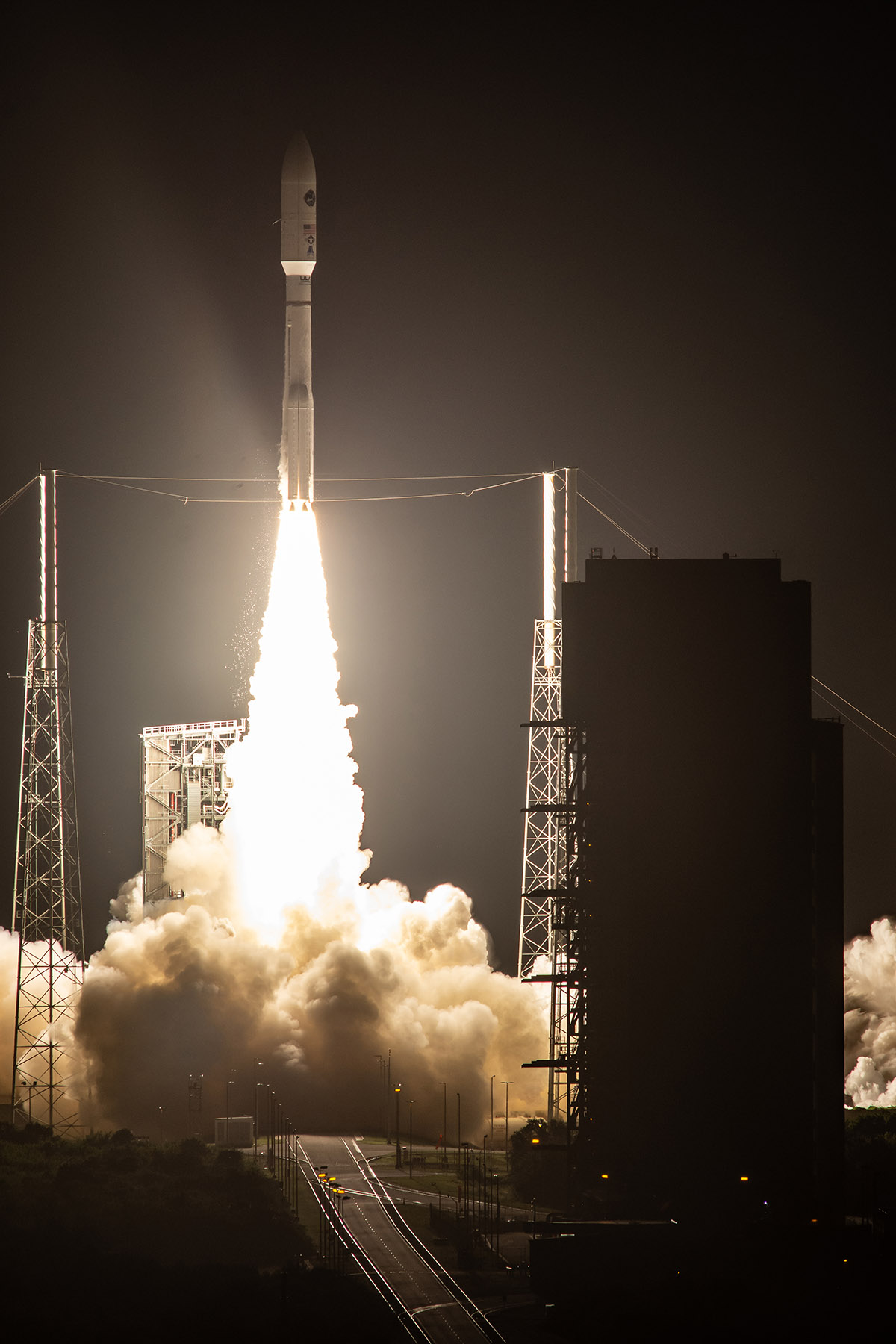
2:30 a.m. EDT (0630 UTC)
T+plus 2 hours, 15 minutes.
A typical rocket ascent to geosynchronous transfer orbit, which is the
standard dropoff point for communications satellites, uses just two
firings by the upper stage to achieve the highly elliptical orbit to
deploy the payloads. From there, the satellites use their own engines in
the subsequent days to fly into the operational locations 22,300 miles
above the equator.
But the Atlas V is enhancing the AEHF-4 satellite’s trip to space
by using all of the vehicle’s performance to deliver the payload with a
much higher perigee, or low point of the transfer orbit, and
significantly reducing inclination relative to the equator. Those
actions by the launch vehicle will benefit the satellite and conserve
its onboard fuel supply by getting AEHF-4 closer to its final orbit.
2:44 a.m. EDT (0644 UTC)
T+plus 2 hours, 29 minutes.
This Atlas Launch Control, we are one hour away from the Centaur engine
restart. The vehicle remains stable as the coast period continues high
above the Indian Ocean.
3:00 a.m. EDT (0700 UTC)
The Atlas V 551 rocket launches to deploy the AEHF-4 communications satellite for the U.S. Air Force. Photo by United Launch Alliance.

3:30 a.m. EDT (0730 UTC)
T+plus 3 hours, 15 minutes.
Today’s launch marks the 250th flight of the Centaur. This venerable
U.S. upper stage is the high-energy, hydrogen-fueled rocket that
unlocked access to the moon and every planet in our solar system for
robotic explorer spacecraft.
The first operational payloads launched by Centaur were Surveyor
missions that sent landers to touch the lunar surface. Mariner missions
went to Mars, Venus and Mercury, Pioneer 10 went by Jupiter and Pioneer
11 visited both Jupiter and Saturn, Vikings 1 and 2 launched to Mars,
Voyagers 1 and 2 explored the gas giants in our outer solar system,
Cassini orbited Saturn, New Horizons flew by Pluto, and more recently
the Mars Reconnaissance Orbiter, Curiosity rover, MAVEN orbiter and
InSight lander all departed Earth for the red planet thanks to Centaur.
The stage has evolved considerably from its early days, becoming
more capable, more powerful and more accurate. It has flown on numerous
Atlas and Titan rocket configurations. Besides planetary exploration,
Centaur has served as a linchpin in launching communications, weather
and military satellites to various Earth orbits for decades.
3:41 a.m. EDT (0741 UTC)
T+plus 3 hours, 26 minutes. Centaur has turned to the proper orientation for the burn.
3:43 a.m. EDT (0743 UTC)
T+plus 3 hours, 28 minutes,
27 seconds. Ignition! Centaur's single Aerojet Rocketdyne RL10C-1
engine is running again for its third firing during this launch, a burn
lasting about 100 seconds.
3:45 a.m. EDT (0745 UTC)
T+plus 3 hours, 30 minutes,
7 seconds. The third main engine cutoff, or MECO-3, is confirmed to
complete the powered phase of flight today. Centaur has performed its
third burn that raised the orbit's low point and reduced orbital
inclination for the AEHF-4 payload.
3:46 a.m. EDT (0746 UTC)
T+plus 3 hours, 31 minutes. Centaur is reorienting to the spacecraft deployment attitude.
3:47 a.m. EDT (0747 UTC)
T+plus 3 hours, 32 minutes,
54 seconds. SPACECRAFT SEPARATION! The Advanced Extremely High
Frequency-4 communications satellite has been deployed into space by the
Atlas V rocket’s Centaur upper stage for U.S. national security.
AEHF-4 will join three predecessors in geosynchronous orbit to
provide global coverage for survivable, protected, anti-jam
communications to strategic commanders and tactical warfighters on land,
at sea and in the air.
4:40 a.m. EDT (0840 UTC)
”ULA’s unparalleled record
of successfully launching and placing payloads in orbit signifies our
profound commitment to national defense,” said Tory Bruno, ULA president
and CEO. “We remain the only launch provider capable of placing our
customers’ payloads into any national security space orbit, anytime,
which we’ve proudly exhibited through 50 launches for the U.S. Air
Force.”
4:43 a.m. EDT (0843 UTC)
“Over the past 12 years,
the men and women of ULA have reliably delivered dozens of Air Force
payloads into orbit from GPS to WGS, and SBIRS to AEHF,” said Gen. Jay
Raymond, commander of Air Force Space Command. “ULA’s unprecedented 100
percent launch success has directly contributed to our national
security. Congratulations to the entire launch team on a successful 50th
launch for the U.S. Air Force.”
4:45 a.m. EDT (0845 UTC)
The traditional quick-look
post-flight data review of today’s mission has occurred at the Atlas
Spaceflight Operations Center following the successful launch of AEHF-4
by the United Launch Alliance Atlas V rocket.
Today’s launch represents the 131st successful mission for United
Launch Alliance and our 50th for the Air Force. This flight also marked
the 79th mission for the Atlas V and continued its 100 percent success
rate.
Liftoff occurred at 12:15:00.2 a.m. EDT at the opening moment of today’s two-hour launch window, with winds of
6 knots from the southeast and a temperature of 80 degrees F.
The vehicle performed successfully during its
three-and-a-half-hour mission, which included three Centaur burns. The
quicklook meeting also reviewed the onboard video camera footage
recorded during spacecraft separation.
Gary Wentz, ULA vice president of Government and Commercial
Programs, presented safe-and-arm pin awards to David Kube, ULA systems
test engineer, and Lee Thompson, ULA quality engineer, for their
“outstanding contribution and personal dedication to the success of the
launch of the fourth Advance Extremely High Frequency satellite.”
Also recognized with Atlas V 551 rocket models were ULA mission
manager Andy McGill and the Air Force’s Col. David Ashley, the AEHF
program manager, and Mike Dolan, the government’s mission director.
Today’s mission occurred on the anniversaries of four previous
launches of ULA heritage vehicles -- one Atlas, two Thor vehicles and
one Delta, including the 1963 Atlas-Arena with Vela nuclear detection
satellites, the 1964 Thor-Agena with a Corona reconnaissance satellite,
another Thor-Agena in 1971 with an experimental Air Force satellite and a
Delta II in 2007 that deployed the GPS IIR-17M navigation satellite.
4:47 a.m. EDT (0847 UTC)
Our next
mission is planned for Nov. 29 from Vandenberg Air Force Base in
California when a Delta IV Heavy rocket launches the NROL-71 mission for
the National Reconnaissance Office.
Launch highlights video
The United Launch Alliance highlights video reliving this Atlas V rocket launch of AEHF-4 is now posted on our YouTube channel!.
250th flight of Centaur
ULA's Rick Beach, Greg Arend and George Kontogiannis talk about the design and evolution of the world's most efficient upper stage. Watch the video on our YouTube channel!.
Rocketcam footage
Video cameras mounted to the Atlas V rocket show the ascent to space with AEHF-4. Watch the video on our YouTube channel!.





















